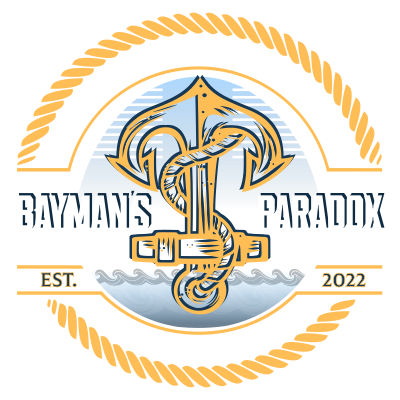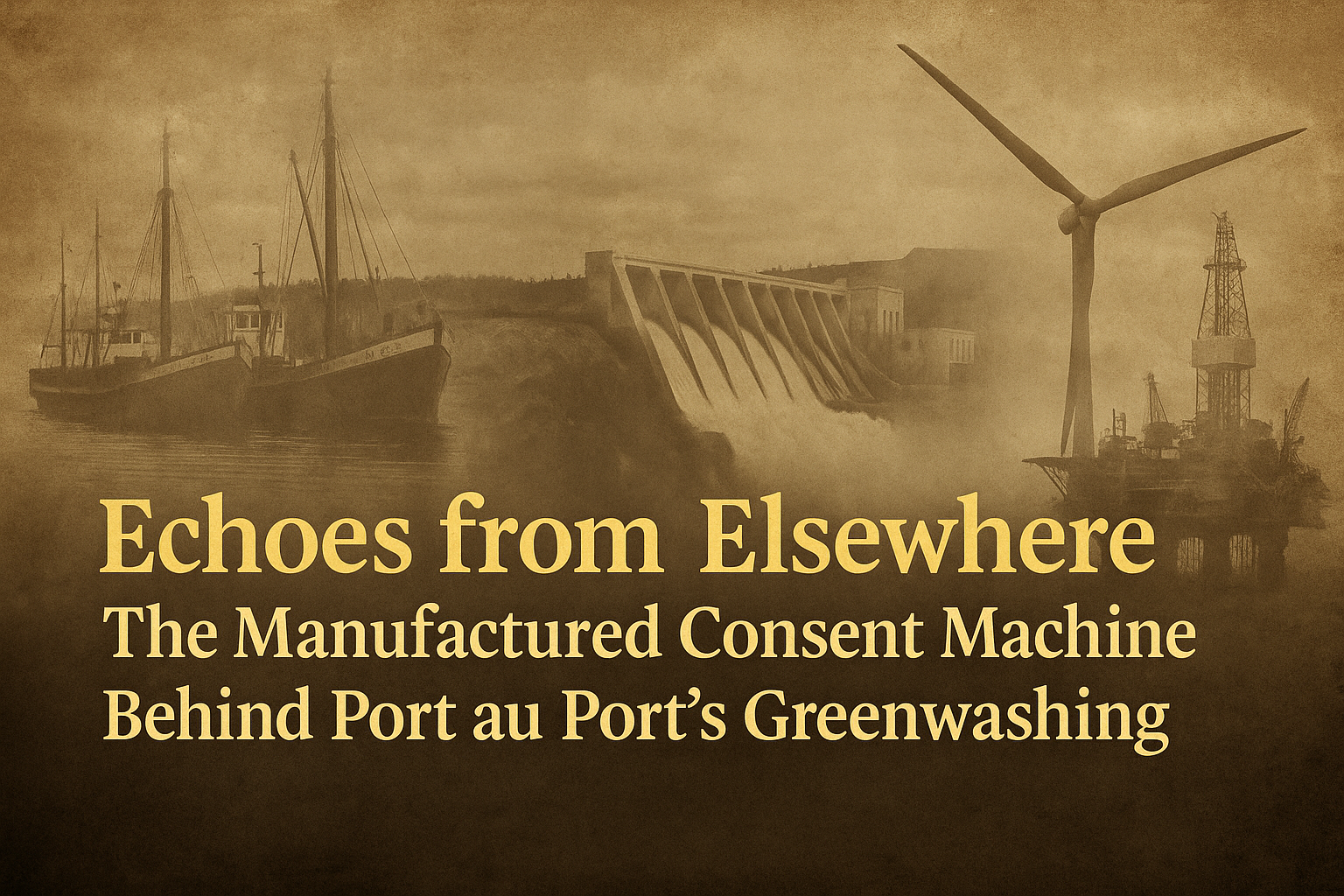The Familiar Script
The Port au Port Peninsula has become the unlikely stage for one of Newfoundland and Labrador’s biggest energy debates. A massive wind-to-hydrogen project, marketed as clean, green, and inevitable, has been positioned as the province’s next economic lifeline. German energy demand is the driver — Berlin signed a “hydrogen alliance” with Ottawa in 2022, branding Stephenville as the “Atlantic Bridge” to Europe. For German policymakers, Port au Port is not an experiment but a supply line.
Yet for locals, the storyline feels familiar. Every major boom — from cod to Churchill Falls, Muskrat Falls, and offshore oil — arrived with promises of prosperity, only to leave behind loss, debt, or disillusion. Media narratives cast the project as jobs and renewal. Residents hear something else: echoes of industries that once defined them, then betrayed them.
This is not simply about turbines or ammonia. It is about how consent is manufactured in fragile regions. The “green transition” in Port au Port is less a community decision than the outcome of a carefully tuned machine — one that blends academic frameworks, government dependency, and global agendas into the appearance of local support.
The Local Paradox as a Playbook
In 2022, Van Assche and colleagues published The Local Paradox, a framework that highlights how grand policy schemes in Newfoundland are repeatedly reshaped by local realities¹. They describe paradoxes that emerge when “grand schemes encounter local realities,” suggesting policy must adapt to fragmented governance, weak institutions, and dependency.
On its face, this sounds like an observation. But in practice, it reads like a roadmap for outsiders. It tells governments, businesses, and consultants what to expect: fractured councils, shallow administrative capacity, and populations eager for external rescue. Rather than fixing weaknesses, it normalizes them.
By naming dysfunction “paradox,” the framework legitimizes workarounds. Instead of empowering communities, policymakers are advised to learn to maneuver through the gaps. For Port au Port, this means that the very disadvantages that undermine real participation are not addressed — they are institutionalized as features of governance. Locals become not partners in decision-making, but variables to be managed.
Municipal Dependency and Soft Budgets
A recent economics paper by Guo (2025) makes this even clearer. Newfoundland’s municipalities face what economists call soft budget constraints: their tax bases are too small, their costs too high, and they survive on provincial transfers and bailouts².
NL has the highest per-capita debt service burden of any Canadian province². Local Service Districts (LSDs) — small, sparsely populated communities — often lack even basic taxation capacity. They rely on provincial guarantees to maintain services, and when debts pile up, the province steps in. This is not occasional — it is structural.
In 2016, the provincial government issued a press release confirming its assumption of municipal debts, stretching repayment schedules, and negotiating ad hoc packages with Ottawa⁷. This bailout logic entrenches dependency. Councils, knowing relief will come, have less incentive to resist provincial direction.
When a megaproject appears, saying “no” is not a real option. Declining risks the grants, debt relief, or emergency funds communities rely on. Compliance is rational, even inevitable. This institutional weakness is the grease in the manufactured consent machine. The appearance of choice remains, but the structure ensures alignment with provincial and federal goals.
Historical Echoes – Trauma as Leverage
Every new promise in Newfoundland is heard through echoes of the past.
- The Cod Collapse (1992): Over 30,000 workers lost their livelihoods in an instant. Communities emptied, traditions fractured. As Bavington shows in Managed Annihilation, the collapse was not simply ecological, but the result of state–science–industry partnerships that rationalized overfishing⁵. People were told it was sustainable, until it wasn’t. Residents still speak of how “all you’ve worked for can be lost in an afternoon.” That trauma lingers — and is now reframed as proof of why new industries must be embraced.
- Churchill Falls (1970s): Once hailed as salvation, the hydro deal locked Newfoundland into a contract so lopsided it was “barely distinguishable from being free” for Quebec. Bannister calls it the end of Newfoundland history as a sovereign actor⁸. Muskrat Falls decades later repeated the cycle — runaway costs, corruption trials, ballooning debt. Locals joke grimly that their grandchildren will still be paying for it.
- New MOU 2024–25: In late 2024, Newfoundland and Labrador and Quebec announced a new Memorandum of Understanding to replace the 1969 Churchill Falls contract. The agreement outlines a revised revenue structure and opens the door for expanded hydro development, including Gull Island. Officials framed it as a historic correction to decades of imbalance — a chance to finally “right the old wrong.” Yet even before the ink dried, critics warned that the language remains vague and that much depends on future negotiations. Once again, Newfoundland is being told it has regained control, even as the fine print remains out of reach.
- Offshore Oil (1990s–2010s): Oil briefly turned NL into a “have province.” But when prices collapsed after 2014, unemployment surged and revenues evaporated³. Communities that had adapted to oil dependence suddenly faced austerity.
- Inshore Fisheries after the Moratorium: Davis & Korneski document how fishers were forced to adapt through policy regimes that erased autonomy, pushing communities further into dependency⁶. Survival was possible only within state-designed pathways.
- Gros Morne National Park: Globally marketed as wilderness, Gros Morne became a UNESCO site. Yet its 2019 management plan shows how Ottawa’s priorities overrode local uses, limiting traditional activities in favor of tourist branding⁴. Another echo: external recognition brought prestige, but locals lost ground.
Each failure becomes an echo used to justify the next. The script is circular: “Because everything failed before, this time you must support the green transition.” Trauma is not just remembered — it is leveraged.
Energy Justice or Consent Theatre?
Academic frameworks of energy justice promise fairer transitions by stressing procedural, distributional, and recognition justice³. Hogan’s study reveals how residents in rural Newfoundland express “sceptical optimism”: they support wind because it might help, but memories of betrayal linger³. One resident summed it up: “We’ve heard this all before.”
Yet the justice pillars often dissolve into theatre:
- Procedural justice = consultation meetings where outcomes are already decided. Atlin & Stoddart show how Muskrat Falls “resets” were staged to rebuild trust without altering the structural imbalance⁴.
- Distributional justice = token tax revenue or a handful of jobs, while profits flow outward. Communities are left with symbolic wins, as your earlier work has shown.
- Recognition justice = rarely achieved. Residents’ memories are treated as nostalgia, not evidence. Emotional testimony is sidelined in favor of “expertise.”
Energy justice thus becomes a vocabulary for greenwashing. It allows developers and academics to frame projects as fair while ensuring dissent is categorized as misunderstanding. For locals, it is another consent ritual — a performance, not empowerment.
The Manufactured Consent Machine in Action
Seen together, the machine has three gears:
- Structural Weakness: Municipal soft budgets ensure local governments can’t resist²⁷.
- Historical Echoes: Memories of cod, hydro, oil, parks, and fisheries are recycled as emotional leverage⁵⁶⁸⁴.
- Consent Rituals: Consultation theatre, “resets,” and symbolic benefits simulate fairness³⁴.
Through this machinery, the Port au Port project is presented as a local opportunity. In reality, decisions were made elsewhere — in Ottawa boardrooms, in Berlin hydrogen strategies, in corporate investor decks.
Echoes from Elsewhere
The project is not a homegrown vision. It is an echo of Germany’s hydrogen alliance with Canada, of EU import targets, of Ottawa’s desire to showcase climate leadership. Newfoundland is not being asked what it wants; it is being told how it will serve.
Local voices are acknowledged only in ritual form, while global agendas set the terms. Port au Port becomes less a pioneer and more a proving ground — not just for wind and hydrogen, but for how far manufactured consent can stretch in fragile communities.
Conclusion – Breaking the Machine
The Port au Port greenwashing story is not unique. It is part of a global pattern where regions with weak institutions and long histories of exploitation are positioned as transition sites. The Local Paradox normalizes dysfunction¹. Soft budget economics enforce dependency²⁷. Historical trauma is weaponized as justification⁵⁶⁸. Consultation rituals reproduce the appearance of legitimacy³⁴.
Breaking this cycle requires more than tweaking consultation. It requires genuine recognition justice: the right to say no, the right to define community futures on local terms, and the right to refuse echoes from elsewhere.
Until then, Port au Port’s future will continue to be written in someone else’s capital — its consent manufactured, its silence mistaken for support, its history recycled into justification for the next grand scheme.
See also
- Credentialed Silence: When Expertise Mutes Dissent
- Rehearsed Truth: How Repeating the Same Story Keeps Newfoundland Stuck
- Kingmaker Dynamics in Newfoundland: Local Gatekeepers and the Politics of Silence
- Green Land, Empty Hands: How Resource Governance Leaves Locals With Symbolic Wins
References
[1] Van Assche, K., Greenwood, R., & Gruezmacher, M. (2022). The local paradox in grand policy schemes: Lessons from Newfoundland and Labrador. Scandinavian Journal of Public Administration https://www.sciencedirect.com/science/article/abs/pii/S0956522122000197?via%3Dihub (Local Download)
[2] Guo, X. (2025). Optimal Transfer Mechanism for Municipal Soft-Budget Constraints in Newfoundland. https://arxiv.org/abs/2508.02171v3 (Local Download)
[3] Hogan, J. L. (2025). The legacy of the cod fishery collapse: Understanding wind energy acceptance in Newfoundland through energy justice and place. Energy Research & Social Science, 127, 104274. https://doi.org/10.1016/j.erss.2025.104274 (Local Download)
[4] Atlin, C., & Stoddart, M. (2022). Public perceptions of hydroelectric projects and trust in government: Muskrat Falls in context. Water, 14(13), 1992. https://www.mdpi.com/2073-4441/14/13/1992
[5] Bavington, D. (2011). Managed Annihilation: An Unnatural History of the Newfoundland Cod Collapse. UBC Press. https://www.ubcpress.ca/managed-annihilation
[6] Davis, A., & Korneski, K. (2012). Inshore fisheries after the moratorium. In Stoddart, Catano & Ramos (eds.), Coastal Communities in Transition. Proxy access: Reade Davis, A Cod Forsaken Place? Fishing in an Altered State in Newfoundland. https://www.academia.edu/11992713/A_Cod_Forsaken_Place_Fishing_in_an_Altered_State_in_Newfoundland
Also see The Newfoundland Fishery: Ten Years after the Moratorium (ResearchGate). https://www.researchgate.net/publication/46488307_The_Newfoundland_Fishery_Ten_Years_after_the_Moratorium
[7] Government of Newfoundland and Labrador (2016) – Executive Council news release https://www.releases.gov.nl.ca/releases/2016/exec/0525n02.aspx
[8] Bannister, J. (2012). A River Runs Through It: Churchill Falls and the End of Newfoundland History. Acadiensis, 41(1), 211–225. https://journals.lib.unb.ca/index.php/Acadiensis/article/view/19083

